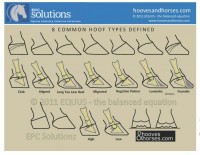
Foot conformation and the duration of competitive life
Considerable time and money are invested in sport horses before they can reach their performance potential later in life. Early retirement due to injuries has, therefore, substantial economic consequences and should be prevented. Musculoskeletal injury is the most significant cause of early retirement and several conformation traits revealed to be related to lameness prevalence. Furthermore, previous research showed the influence of limb conformation on not only the duration of equine sports careers but also on sports performance.
Databases of the Royal Dutch Warmblood Studbook (KWPN) and of the Royal Dutch Equestrian Sports Federation (KNHS) were matched and resulted in a dataset comprising 23,116 records of horses for which their conformation scores and duration of their sports career were available. Survival analysis was used to determine which of the conformation traits had a significant effect on the duration of sports career in dressage and jumping at a basic and elite level.
Horses participating at the elite level had received in general less negative scores at studbook entry, thus having longer necks, higher heels, more dry legs and they had a higher score for conformation grade, counting in particular for the elite dressage horses. Duration of competitive life was shorter for jumping than for dressage. A different set of risk factors was found for each level and discipline. Though, the trait ‘uneven feet’ shortened the competitive life in both disciplines, with the elite jumping horses at biggest risk.
Expert opinion by Isabeau Deckers
Limb conformation and, in particular, the conformation of the distal limb, is important for the duration of competitive life. From the prevalence of uneven feet in sports disciplines, it may be concluded that this is an undesirable trait, particularly at the elite level of jumping. Therefore, breeders should be encouraged to avoid this phenomenon starting at foal age.
> From: Ducro et al., Equine vet. J 2 (2009) 144-148. All rights reserved to W. Back. Click here for the online summary.


